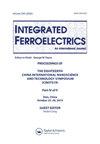镧改性BaTi 0.91 Sn 0.09 o3陶瓷的经典到弛豫铁电转变
IF 0.7
4区 工程技术
Q4 ENGINEERING, ELECTRICAL & ELECTRONIC
引用次数: 0
摘要
本文章由计算机程序翻译,如有差异,请以英文原文为准。
Classical to Relaxor Ferroelectric Transformation of Lanthanum Modified BaTi 0.91 Sn 0.09 O 3 Ceramics
Abstract Lead-free Ba1-xLaxTi0.91Sn0.09O3 (BLTS) ceramics with x = 0, 0.01, 0.03 and 0.05, were prepared by the traditional solid-state sintering method with calcination and sintering temperatures of 1200 °C for 2 h and 1400 °C for 4 h, respectively. X-ray diffraction (XRD) measurements revealed that all the BLTS ceramics had pure perovskite structures with no detectable impurities. When x = 0 and 0.01, the ceramics exhibited coexisting orthorhombic (O) and tetragonal (T) phases, while the orthorhombic (O), tetragonal (T) and cubic phase (C) were detected in the BLTS ceramics with x = 0.03 and 0.05, which the Rietveld refinement analysis confirmed. Furthermore, increasing x in the BLTS ceramics led to a large decrease in the average grain size (from 45.7 to 0.9 µm). A significant decrease in the remnant polarization (P r) accompanied by very slim hysteresis loops were observed for higher La (x ≥ 0.03) levels. This demonstrates that BLTS ceramics transition from classical ferroelectric to relaxor ferroelectric behavior due to changing occupancy of the A-site to La3+ from Ba2+.
求助全文
通过发布文献求助,成功后即可免费获取论文全文。
去求助
来源期刊

Integrated Ferroelectrics
工程技术-工程:电子与电气
CiteScore
1.40
自引率
0.00%
发文量
179
审稿时长
3 months
期刊介绍:
Integrated Ferroelectrics provides an international, interdisciplinary forum for electronic engineers and physicists as well as process and systems engineers, ceramicists, and chemists who are involved in research, design, development, manufacturing and utilization of integrated ferroelectric devices. Such devices unite ferroelectric films and semiconductor integrated circuit chips. The result is a new family of electronic devices, which combine the unique nonvolatile memory, pyroelectric, piezoelectric, photorefractive, radiation-hard, acoustic and/or dielectric properties of ferroelectric materials with the dynamic memory, logic and/or amplification properties and miniaturization and low-cost advantages of semiconductor i.c. technology.
 求助内容:
求助内容: 应助结果提醒方式:
应助结果提醒方式:


